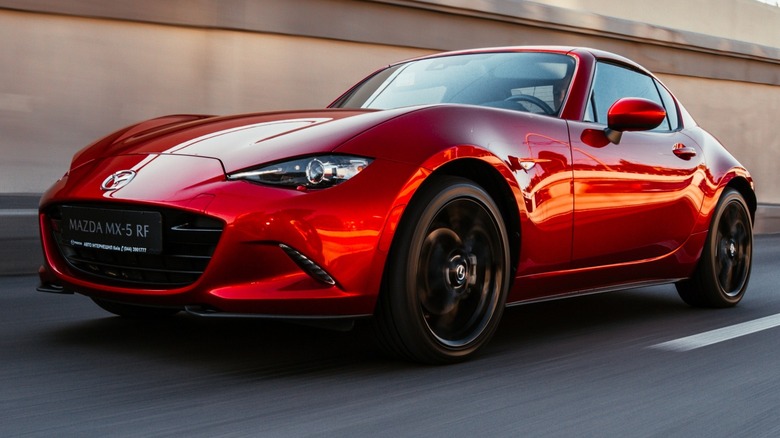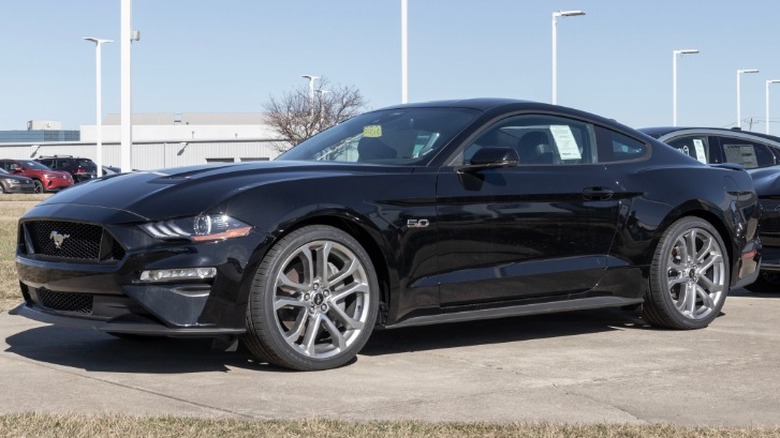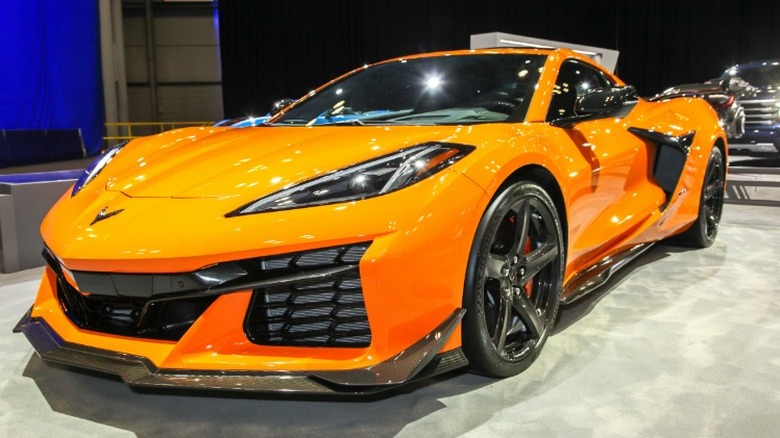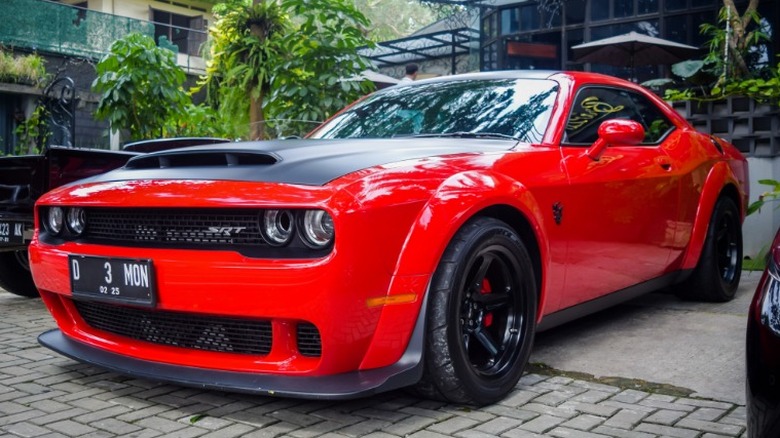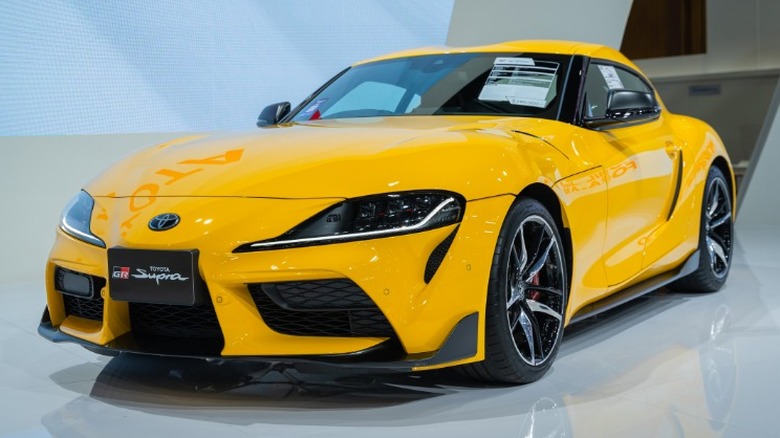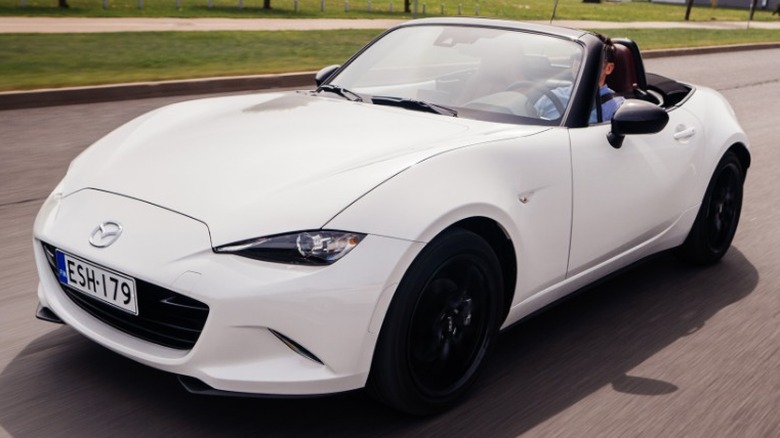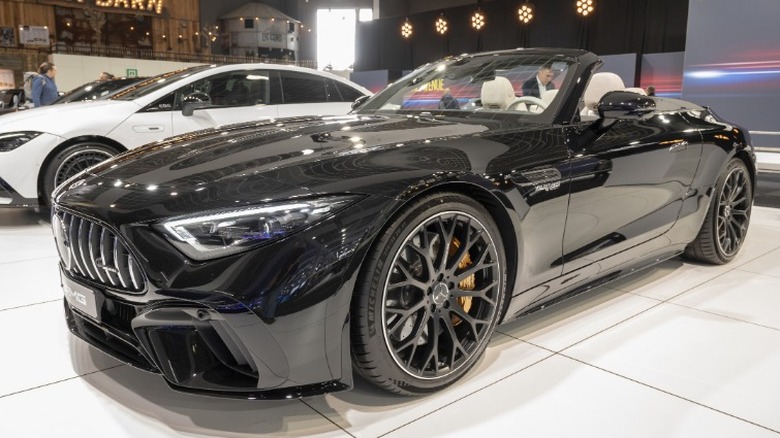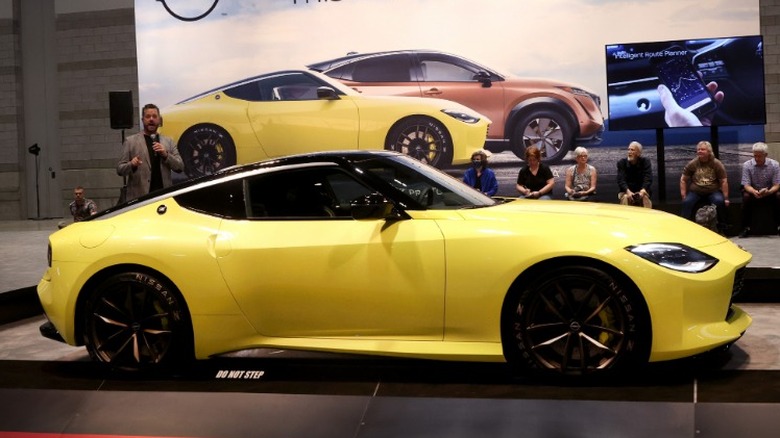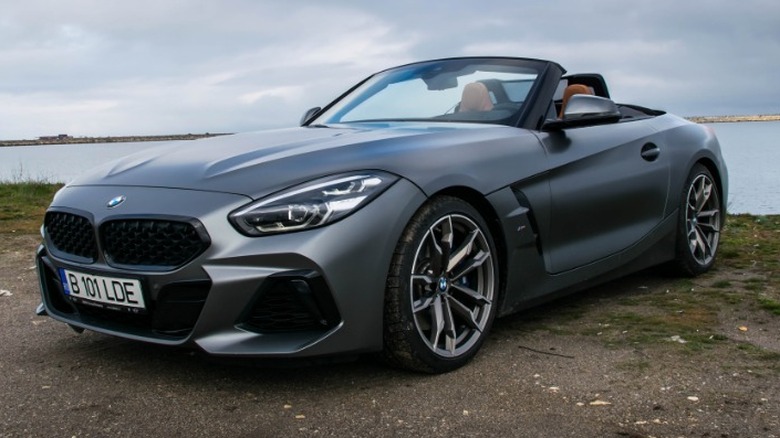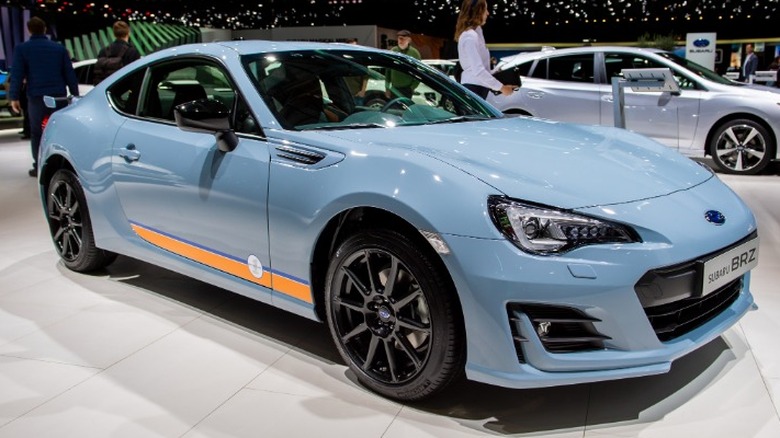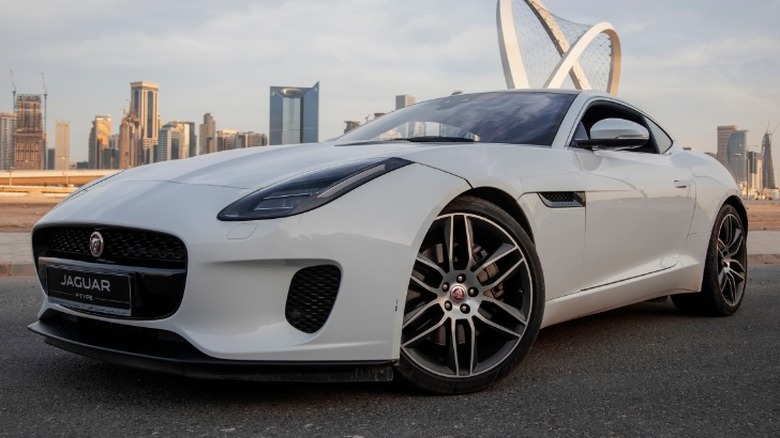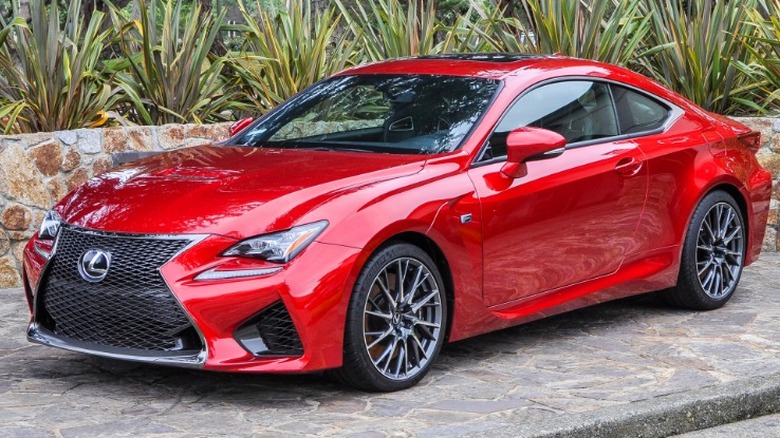The Best Sports Car From Every Major Brand
Defining a sports car in the modern age is not as straightforward as it may seem. It used to be a small two-seater car with a soft top, such as an MGB or Triumph Spitfire. But few cars like that are still produced. Mazda's MX-5 is about the only mainstream car that fits that description left, so sticking with a traditional definition would make for a very short list. In modern parlance, most people might think a sports car is something with two doors built with an emphasis on fast driving and little consideration for practicality. That opens the field up a bit, but still leaves a shorter list than in previous eras as auto manufacturing has largely shifted to four-door automobiles, especially SUVs.
Despite the shifts in the industry, many excellent sports cars remain on the market. The demand for fun cars with good performance will likely never go away, so manufacturers will always cater to this niche. Therefore, the lots of most dealerships have some car on offer with some degree of sporty styling and at least a moderately high-performing drivetrain. For a more detailed look at that selection, here are the best sports cars from every major brand available for sale right now.
Ford Mustang
The perennial favorite sports car from the Blue Oval has been in production for more than half of a century and is going strong today. The Mustang is a showcase of affordable performance that has stuck to the same basic formula throughout its production, an RWD car with two doors and a big engine up front.
The 2023 Mustang, with a base price of $29,145, comes with a choice of engines including the base EcoBoost four-cylinder engine up to the range-topping 470-horsepower V8 of the Mach I. The Mustang has come a long way over the years, and the current model offers fully independent suspension that offers excellent handling while maintaining reasonable levels of comfort. Interiors are also significantly improved over previous generations and offer excellent quality with a long list of convenience features from a large touchscreen infotainment center to customizable digital gauges.
Even with the 330 horsepower of the base model, which is more than the power of GT models of the '90s, the Mustang is an excellent choice for a sports car. While it is relatively affordable, top-of-the-line models are near $60,000, which puts them into another tax bracket but offers a lot more fun.
Chevrolet Corvette
The latest generation of the Chevrolet Corvette, the C8, strays a bit from the design of a traditional sports car because its engine has been moved behind the passengers. The original 1953 Corvette, however, was the epitome of an American sports car with its curvy fiberglass body, lack of a roof, and American iron — it would be a couple of years before a V8 replaced the original underpowered straight-six — powering the wheels from up front. This model has evolved much over the years from a fun and sporty runabout to a full-force powerhouse capable of keeping up with exotic supercars from Italy for less than half the price.
Today's Corvette is driven by an all-aluminum LT2 V8 attached to a lightweight frame of aluminum as well. Continuing with tradition, the body is made of fiberglass, making the overall weight of the car remarkably low. Motivation comes courtesy of the base model's 490 horsepower and is transferred to the wheels via a dual-clutch automatic transmission. For those seeking a bit more excitement, Chevrolet also offers the 670-horsepower Z06, which gains its tremendous power boost from having a flat-plane crankshaft and dual-overhead camshafts along with many other advanced engineering upgrades.
The current Corvette is considered by many to be the coolest car available from an American company and is unique among its peers. Compared to European rivals the Corvette can be had for bargain basement prices with base models a bit more than $60,000 and the top-of-the-line Z06 convertible setting you back a hair less than $110,000, or about $200,000 less than a comparable Ferrari.
Dodge Challenger SRT Demon
While the Challenger platform is getting a bit long in the tooth, Dodge has managed to keep it fresh by simply stuffing as much power as possible under the hood. In its more than a decade of existence, the styling of the Challenger has been refreshed and updated but has only been cosmetic upgrades. The car still retains the classic shape drawn from its retro inspiration back in 2008 when it came out and still looks fresh today.
The first release of a ridiculously powered Challenger came in 2015 with the SRT Hellcat, which was powered by a supercharged 6.4-liter HEMI V8 making an incredible 707 horsepower. It was the talk of the town for being the most powerful American production car ever and became an instant hit. Not satisfied to rest on their laurels, Chrysler engineers set out to break that record with the new SRT Demon 170 now squeezing an astonishing 1,025 horsepower from its 2023 model, which is up from the already ludicrous 840 horsepower of the inaugural 2018 model.
2023 marks the year the most powerful American production sports car became available, but it also marks the end of an era as Challenger production ends after this. The Demon 170 is also the most expensive Dodge ever produced at $100,361. As parent company Stellantis shifts its focus over to electric drivetrains, the value of this car, which is limited to about 3,300 units, is sure to increase.
Toyota GR Supra
Toyota showed the world that it could build a world-class sports car when it introduced the MkIV Supra back in 1993, which has since become a motoring legend. Leaving the American market in 1998 and the Japanese market in 2002, Toyota had an omission in its lineup until it brought back the Supra nameplate in 2019 with an all-new model developed in partnership with BMW.
Without a suitable engine to power a new sports car, Toyota chose to adopt BMW technology to save costs but did not merely slap Toyota badges on a BMW Z4. The car's styling and suspension are unique to the Toyota and the engine is tuned specifically for this car. The results of this collaboration are an attractive, sporty, and engaging car with plenty of potential that differs itself considerably from its BMW brethren.
Three years on since its introduction, Toyota offers the GR Supra, so named Toyota's Gazoo Racing in-house performance tuner. It offers a 3.0-liter straight-six turbocharged engine that gets the Supra from 0-60 in just 4 seconds thanks to its 382-horsepower output. Inside the car, you may notice familiar BMW touches such as the Toyota branded iDrive system along with certain knobs and switches, but the exterior is all Supra, and that looks pretty good. Plus, for a sporty car with brisk acceleration that can be bought fully loaded for less than $60,000, the new Supra is hard to beat.
Mazda MX-5
Since its debut in 1989, the Mazda MX-5, or Miata in North America, has been the favorite among many drivers. Its clever packaging incorporating modern Japanese mechanicals and electrical systems into a traditional British sports car format struck a chord when it arrived and became a sales success from the start.
While the original car was never high-powered and fast, having only 116 horsepower and a 0-60 time of 8.6 seconds, its nimbleness, low weight, and balanced chassis made it a pleasure to drive and that is what made it stick with buyers. While many of its stats have improved, the nature of the car has remained. The current MX-5 is modestly improved in performance, now making 181 horsepower, but the rest of the car is significantly more refined. It retains a perfect 50/50 weight balance with improved traction thanks to things such as torque vectoring for superior control. Transmission options now include six speeds in either manual or automatic forms, and driving with either is still a blast.
After 30 years, the MX-5 is still a favorite and one of the few traditional sports cars on the market. While it is also a favorite among amateur racers, it appears as long as everyday consumers keep buying it, Mazda will keep making it.
Mercedes-Benz AMG SL 63
At the opposite end of the spectrum from the simple Mazda MX-5 is the opulent and powerful Mercedes-Benz AMG SL 63. While walking a fine line between that of a luxury roadster and an all-out performance coupe, the AMG SL delivers the best of both. Powered by a 4.0-liter, twin-turbo V8 making a healthy 577 horsepower, this luxury cruiser launches up to 60 in just 3.5 seconds. To help tame all that power to the ground, the SL is driven by all four wheels, meaning you will miss out on any tire-squealing fun in the corners in favor of incredible grip keeping the car headed in the same direction it's pointed. That's maybe less adolescent fun, but practical for genuine high-speed driving, especially with AMG's active ride control including an advanced active hydraulic anti-roll stabilization.
Inside the car, you will find many familiar Mercedes touches styled with a bit of extra flair to match the car's sporting credentials. There is no shortage of powered adjustments all around the cabin from the seats to the touch screen. For top-down driving, air vents below the headrest funnel air to the back of the neck, and the touch screen is motorized to adjust the angle to reduce glare. As is expected from Mercedes-Benz, this car offers the pinnacle of luxury sports car ownership but comes with a commensurate price tag. While the base price sits at $178,350, most models will push up and over the $200,000 mark with options.
Nissan Z
The all-new Z from Nissan replaces the 13-year-old platform of the 370Z, which was overdue. Nissan's first model to wear the Z debuted in 1970 with the 240Z featuring an inline-six 2.4-liter engine making 151 horsepower. While that car made a good impression and has since turned into a valuable classic, the new Z seems to attempt to channel some of the energy of the original.
While the new car is a fresh and thoroughly modern concept, it displays cues to the original such as the inset headlights and long sloping rear hatch. This continues with the crease running from the fender to the door, the shape of the rear quarter windows, and the horizontal tail lights. We find a more typically modern affair inside with a nod to the past in the triple gauge set sitting high on the center of the dashboard. It is a fitting tribute and successor.
Unlike the original, this car is propelled by a 3.0-liter V6 — down from the 3.7-liter in its successor — fed by twin turbochargers to produce 400 horsepower. Manual transmissions may be getting rare, but the Z offers a six-speed manual or nine-speed automatic driving the rear wheels only. All this gives the car a time to 60 mph of 4.5 seconds, which is not the fastest by today's standards, but certainly quick enough for most of us and more than enough for public roads. You won't be carrying much luggage in this car, but you will likely enjoy driving it, and that is really the point.
BMW Z4 M40i
While closely related to the Toyota GR Supra, the BMW Z4 M40i is a different and distinct automobile. Developed not to be BMW's all-out high-performance car, the Z4 is more aptly called a luxury sports car. This model is a strictly soft-top roadster with much better-than-average performance on a lightweight platform. The M40i is the high-performance version of this model and carries a turbocharged 3.0 straight-six making 382 horsepower — the sDrive30i is a four-cylinder car with 255 horsepower. With a low curb weight of 3,457 pounds, 0-60 is just 3.9 seconds, which is fast by any measure.
Although this car is very fast, it is only offered with an automatic transmission as it is not a strictly high-performance model. For fast driving, BMW offers cars like the M8. For those who appreciate a sporty and fun car that offers luxury with a bit more than modest performance, the Z4 is a good choice. Inside you will find Vernasca leather-wrapped seats and a 12.3-inch touchscreen with the latest version of iDrive in a typically nicely trimmed interior, although it may feel a bit cramped and the top can be lowered in 10 seconds while on the move.
The current Z4 fills the BMW lineup today much as it has in the past, by offering an upscale car with good performance for those whose priority is in spirited driving over practicality. Pricing ranges from $55,000 to $75,000, which may not be the best value, but then again, nobody buys a BMW for value.
Subaru BRZ
Subaru joined Toyota in development of a new affordable sports car years back and ended up with the Toyota FR-S (now GR86) and its version, the BRZ. Now in its second generation, the BRZ continues as a fun and affordable sports car that offers good performance in a package offering a pure driving experience.
The BRZ went through a major redesign just a year ago after having been on the market for a decade. The updated car remains an attractive RWD sports car offering seating for four, but really only has room for two. It's not meant to be practical, but the suspension and weight balance do make it great to drive and something that feels at home on the track. The 2.4-liter engine shared by Toyota and Subaru models is a traditional Subaru boxer design that offers 228 horsepower. With its modest power rating, this car is not ever going to be a track monster without serious modification, but it does offer enough to be highly engaging and fun to take to its limits without losing control.
The interior is nice enough and comparable to modern Subaru quality, but this car is still all about the drive. It is built upon a relatively simple formula that has been working for more than a decade, so Subaru has not done much to mess with it. This is a perfect choice for those who love driving and have a smaller budget but it also makes a perfect track car without much effort from a few mods.
Jaguar F-Type R75
The big Jaguar coupe is more of a luxury grand tourer, but what to call it doesn't matter once you are behind the wheel of this svelte and powerful machine. The F-Type has been around for some time — a decade, an eon in car terms — but remains competitive and stylish still. However, Jaguar has announced the retirement of this model after the 2024 model year, but not before going out with a bang. The F-Type has been available up until now with a four-cylinder in the base model and a beefy six-cylinder in the uplevel car. In an unusual move, Jaguar has scrapped all engine options and fitted the F-Type with a supercharged V8 as the only option, which is available with either a 444 horsepower rating or, in the R75 trim, 575 horsepower.
Jaguar is moving toward all-electric propulsion, and that makes this car a fitting sendoff. One of the things this manufacturer has always been known for is crafting elegant, luxurious, and sporty automobiles. The F-Type is no exception. Although the platform is 10 years old, it is still captivating and still an excellent drive. The age does show in some of the components inside the car as the infotainment and navigation are a bit dated and not up to today's standards. Shortcomings notwithstanding, the interior is an exquisite place to be and very easy on the eyes. Furthermore, once you mash down on the pedal and push the adaptive suspension to its limits, any niggles with the technology will dissolve.
While Jaguar's new electric vehicles will certainly be excellent cars demonstrative of typical English luxury, the last F-Type may make us pine for the good old days. If there is a way to say goodbye and make you long for more, the F-Type is it.
Lexus RC F
When Toyota introduced the Lexus brand, it created a new benchmark for sophisticated luxury cars. In the intervening years, that brand has come to be known as the reliable partner of bankers and doctors, but not so much the brash and flamboyant well-to-do playboy. That image may be wrong and the RC F could prove it.
You can purchase a new RC with either a turbocharged four-cylinder or bump up to the 311-horsepower, 3.5-liter V6 and get a car with excellent performance, but for pushing the boundaries of good taste, opting for the 472-horsepower, 5.0-liter V8 RC F is the obvious choice. Despite being generously powered, the RC is still shrouded in a relatively modest shell that is careful not to announce its present too flamboyantly, although the F trim provides a few aggressive hints that this is not a car typical of someone from accounting.
Perhaps the best reasons to have an RC F are typical of why you should want a Toyota. The car is well-designed with engineering that ensures it will work as intended year after year. And even though Lexus prides itself on building quality vehicles, it still comes with a generous warranty of four years for the car and six for the powertrain. Out of all the sports cars available, for anyone who wants one to drive every day, the RC F is a solid bet.
